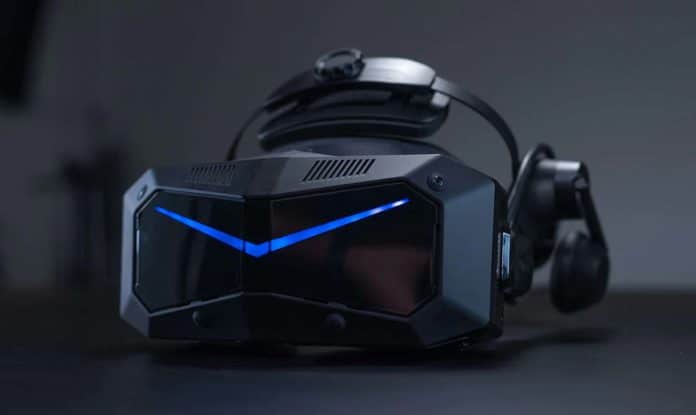Last Update on November 17, 2025
TL;DR
- What is the Pimax Crystal Super: a razor-sharp PCVR headset with aspheric lenses, 50- or 57-PPD optics, FOV 127° H (50 PPD) or 106° H (57 PPD), 72/90 Hz, plus eye-tracking + DFR (dynamic foveated rendering).
- Who it’s for: flight sims and sim-racing where long-range readability (PFD/MFD, apexes, braking boards) is critical.
- Real-world PC spec: min RTX 2080 / rec RTX 3070+; for heavy scenes/games aim for RTX 4070 Ti → 4090 + recent i7/i9, 32–64 GB RAM.
- Starter multi-sim setup: FOV Normal/Balanced, AA 2x (4x if headroom), Textures High, Aniso 8x; lock 36/40/45 fps at 72/80/90 Hz for rock-solid stability.
- Indicative pricing (ex-tax, varies by region/bundles): $1,735–$1,787 (US, Prime/installments available); EU varies by shop/bundle. Check Pimax’s purchase page.
Why the Pimax Crystal Super stands out
- High clarity & PPD: distant details are easier to read (cockpit text, braking markers, far scenery).
- Aspheric lenses: wide sweet spot, even sharpness, minimal reflections.
- Wide FOV: stronger “big cockpit” immersion and peripheral awareness.
- Eye-tracking + DFR: rendering is concentrated where you actually look.
- High-contrast panels (QLED+MiniLED or Micro-OLED depending on version): deep blacks, excellent night readability.
- Inside-out (SLAM) tracking out of the box, with an optional Lighthouse faceplate.
Essential spec sheet (Pimax Crystal Super)
- Per-eye resolution: 3840×3840 (QLED+MiniLED); 3840×3552 (Micro-OLED).
- PPD / optics: 50 PPD (127° H FOV, up to ~138° in Labs) ; 57 PPD (106° H FOV).
- Refresh rates: 72 / 90 Hz (Super max).
- Lenses: aspheric (large sweet spot).
- Features: Eye-tracking, Auto-IPD, Dynamic Foveated Rendering (DFR).
- Tracking: native inside-out (SLAM); Lighthouse faceplate optional.
- Ecosystem: Pimax Client (or PiTool) + SteamVR.

Pimax Crystal Super vs Crystal Light vs Crystal (OG) — which to choose?
| Criterion | Crystal Super | Crystal Light | Crystal (OG) |
|---|---|---|---|
| Per-eye resolution | 3840×3840 (QLED/MiniLED) or 3840×3552 (Micro-OLED) | 2880×2880 | 2880×2880 |
| PPD (optics) | ~50–57 (aspheric) | ~35–42 | ~35–42 |
| FOV | 127° H (50 PPD) / 106° H (57 PPD) | Wide | Wide |
| Refresh rate | 72/90 Hz | up to 120 Hz (profiles) | 120 Hz (profiles) |
| Eye-tracking / DFR | Yes (native) | No | No |
| Tracking | Inside-out (+ optional Lighthouse) | Inside-out (+ optional Lighthouse) | Inside-out (+ optional Lighthouse) |
| Audience | Demanding simmers (flight/racing) | Value for money | Previous generation |
FOV/PPD reference: 50 PPD = 127° H (up to ~138° in Labs) · 57 PPD = 106° H · Micro-OLED 50 PPD ≈ 116° H.
Use-case at a glance
- Super: max clarity, wide FOV, DFR → ideal for flight sims and sim-racing focused on long-range readability.
- Light: excellent price/quality balance for strong PCs on a tighter budget.
- OG: previous generation; interesting second-hand if the price is sharp.
PC requirements — minimum, recommended, best experience
- Official minimum (casual/medium): RTX 2070/3060 (or RX 5700 XT/6700 XT), i5-14xxx / i7-12xxx / i9-10xxx+, 32 GB RAM.
- Pimax recommended: RTX 3070+ for a good overall experience.
- Best experience (heavy sims): RTX 4070 Ti → 4090 + recent i7/i9, 32–64 GB RAM.
Detailed tiers
Minimum (entry / medium quality)
- GPU: RTX 2070–3060 / RX 5700 XT–6700 XT
- CPU: i5-14xxx / i7-12xxx / Ryzen 5–7 equivalents
- RAM: 32 GB • DP 1.4a, USB 3.0, Windows 10/11
Recommended (medium/high sims)
- GPU: RTX 3080–4070 / RX 6800–6950 XT
- CPU: i7-13xxx / i9-12xxx / Ryzen 9 7900+
- RAM: 32–64 GB
Best experience (high quality, heavy scenes)
- GPU: RTX 4070 Ti → 4090 / RX 7900 XT/XTX (and next-gen)
- CPU: i9-13/14xxx / Ryzen 9 7950X(3D)
- RAM: 64 GB recommended for AAA flights + heavy mods
Suggested PC builds (2025)
Budget “Super starter”
- GPU: RTX 4070 / RX 7800 XT
- CPU: i5-13600K / Ryzen 7 7700
- RAM: 32 GB DDR5
- Target: 36–40 fps lock (FOV Normal/Balanced) with moderate Clouds/AA.
Balanced
- GPU: RTX 4070 Super / RTX 4080 Super / RX 7900 XT
- CPU: i7-13700K / Ryzen 7 7800X3D
- RAM: 32–64 GB
- Target: 40–45 fps stable, AA 2–4x, Clouds High-.
High-end / “no compromise”
- GPU: RTX 4090 (or next gen)
- CPU: i9-14900K / Ryzen 9 7950X3D
- RAM: 64 GB
- Target: 45 fps almost everywhere (FOV Normal/Balanced), AA 4x, heavy weather OK.
Games that benefit most from the Crystal Super
Flight simulation
- Microsoft Flight Simulator (2024/2020): crisp cockpits, clean distant horizon; DLSS Quality + DFR if available; aim for a 36–45 fps lock.
- X-Plane 12 (VR): excellent MFD/HUD readability; Clouds are expensive → start at High-.
- DCS World: Super’s contrast/brightness shines; keep SSAA/MSAA modest.
- VTOL (VR): native VR with controller-first interfaces; very readable on the Super; run 72–90 Hz with a 36–45 fps lock depending on mission complexity.
Mini-bench MSFS (Clarity / Balanced)
- Clarity (4090/14900K): DLSS Quality, T-LOD 150, Clouds High- → 45 fps lock stable (90 Hz ½), very sharp cockpit, limited AI/traffic.
- Balanced (4070S/7800X3D): DLSS Quality, T-LOD 120, Clouds High- → 40 fps lock, solid cockpit readability; watch for overcast.
Sim-racing
- iRacing: long-range boards/apexes are clearly readable; ASW/reprojection helps maintain 45 fps.
- Assetto Corsa Competizione / Assetto Corsa (Classic): weather/lighting look superb; the Super’s resolution really pays off.
- rFactor 2 / Automobilista 2: use Cockpit Clarity profile (AA 4x), FOV Normal.
Mini-bench ACC (Clarity / rain)
- Clarity (4090/14900K): AA 4x, EPIC/High mix, medium rain, 20 AI → 45 fps lock stable, cockpit and apexes clean.
- Balanced (4070/13600K): AA 2x, High mix, 15 AI, light rain → 40 fps lock, small drops at race starts.
Other (PCVR)
- Study-level (space/submarine, etc.): fine text, checklists and MFDs are far more comfortable.
- AAA PCVR: prioritise stability (36–45 fps) over chasing “90 Hz everywhere”.
“Ready-to-play” VR presets
Cockpit Clarity
80–90 Hz · AA 4x · Textures High · Aniso 8x · Objects High · Clouds High- · Shadows/Ref Minimal → 40–45 fps.
Balanced
72–80 Hz · AA 2x · Textures High · Aniso 8x · Objects High · Clouds High- · Shadows/Ref Minimal → 36–40 fps.
Performance
72 Hz · AA Off–2x · Textures High- · Aniso 4–8x · Objects Medium-High · Clouds Medium-High → 36 fps lock.
If it still stutters: Clouds → AA → World Objects → Resolution (runtime and/or game).
Benchmark method
- Fixed scene: same airport/track, same time/weather.
- 3-minute routine: ~30 s taxi → take-off → level 1500 ft (flight) / one timed lap (racing).
- Measurement: half-rate lock (36/40/45), watch stability/pacing + long-range readability.
- Iterations: change one variable at a time (Clouds, AA, FOV, bitrate).
GPU performance table (realistic lock targets)
| GPU tier (examples) | MSFS | X-Plane 12 | iRacing / ACC | Tips & profile |
|---|---|---|---|---|
| RTX 3060 / 4060 / RX 7600 | 36 fps (72 Hz) | 36 fps | 36–40 fps | Balanced; Clouds High-; AA 2x |
| RTX 3070 / 4060 Ti / RX 7700 XT | 36–40 fps | 36–40 fps | 40 fps | Balanced → Clarity (scene-dependent) |
| RTX 4070 / 4070S / RX 7800 XT | 40 fps | 40 fps | 40–45 fps | Cockpit Clarity (AA 4x), FOV Normal |
| RTX 4080 / 4080S / 4090 / RX 7900 XTX | 40–45 fps | 45 fps | 45 fps | Clarity (AA 4x), Clouds High- |
Indicative only: validate with your 3-minute routine. In dense overcast, first drop Clouds.
Pros & cons (Pimax Crystal Super)
Pros
- Clarity and FOV above most mainstream PCVR headsets.
- Inside-out from day one + optional Lighthouse.
- DFR + eye-tracking: better GPU efficiency at high perceived quality.
Cons
- If you want to take sims at a higher level, you’ll need a powerful PC build
- 90 Hz max: the goal is a stable half-rate lock, not chasing raw Hz.
Pricing & availability (updated: November 9, 2025)
| Model | Region | Indicative price* | Prime payment | Notes |
|---|---|---|---|---|
| Pimax Crystal Super (QLED+MiniLED, 50/57 PPD) | US | $1,735 – $1,787 (ex-tax) | Deposit + balance after trial (Prime) | Official US purchase page |
| Pimax Crystal Super (Micro-OLED) | US | Similar range to QLED/MiniLED Super | Prime available | Micro-OLED page (specs/PPD/FOV) |
| Crystal Super (EU) | EU | Varies by bundle/retailer | Depends on shop | EU page + resellers (UnboundXR/Bestware) |
| Pimax Crystal Light | US | $858 – $887 (ex-tax) | Upfront/installments (2025 offer) | Official Light page |
* Prices fluctuate with taxes, currency, bundles (DMAS/Lighthouse faceplate) and promos. Always check the official store and/or your retailer at purchase time.
Is there any Promotions & codes?
Pimax often runs attractive promos.
Codes:
- –3% on Pimax Crystal Super: oVRdoz03
- –8% on Pimax Crystal Light: oVRdoz08
Black Friday:
- Crystal Light: $70 off the first payment + extra 3% off with promo code
- Crystal Super: Extra 3% off the first payment with promo code, plus free “Worry-Free Return” service and a 3-month extended warranty
Note: The promo code and the Black Friday promotion can be combined! Take advantage of Black Friday to stack both offers and get your Pimax Crystal Super at a reduced price.
For more VR-related deals, you can check out our page: All VR Deals – Black Friday.
Get the Pimax Crystal Super
To get the Pimax Crystal Super at a low price, use the link During Black Friday, and apply the code above at checkout to secure the extra discount : Pimax Crystal Super
Handy checklists

Before each session
- Headset/controllers OK
- Pimax Play Client/SteamVR running
- No overlays/recorders
- 36/40/45 fps lock set
- Fixed weather/time (flight) / stable conditions (racing)
If performance drops
- Clouds ↓
- AA → 2x
- World Objects → Medium-High
- Close heavy background apps
- Check GPU/CPU temps
FAQ (People Also Ask)
Is the Pimax Crystal Super better than the Crystal Light?
Yes: higher clarity/PPD, wider FOV, eye-tracking + DFR, and more options (Lighthouse/DMAS). It’s pricier and needs a stronger PC.
What PC do I need?
Minimum around RTX 2070/2080, recommended RTX 3070+; for a “best experience,” aim RTX 4070 Ti → 4090 (or equivalent), recent i7/i9, and 32–64 GB of RAM.
Does it work without Lighthouse base stations?
Yes, via inside-out tracking. You can add a Lighthouse faceplate to switch to SteamVR tracking.
Is 90 Hz enough for sims?
Yes: stability (a 40–45 fps half-rate lock) matters more than chasing max Hz in flight/racing.
QLED/MiniLED vs Micro-OLED?
Micro-OLED brings very deep blacks and a “cinema” feel; QLED/MiniLED excels in brightness/impact. Both benefit from the aspheric lenses.
Pimax Crystal Super or Light for sim-racing?
Super if you want the best clarity and your GPU can handle it; Light if you prioritise budget while keeping a very sharp image.











